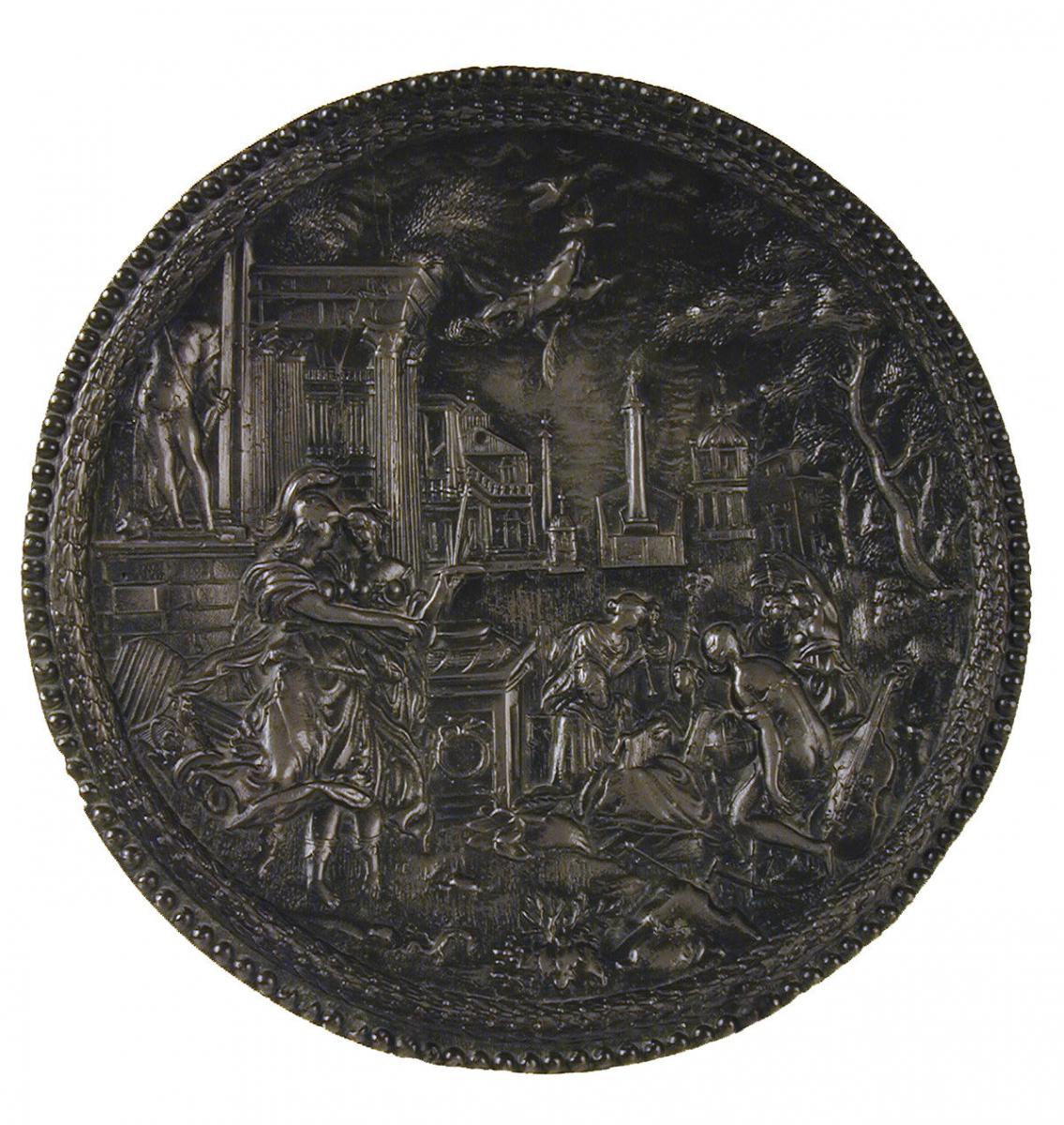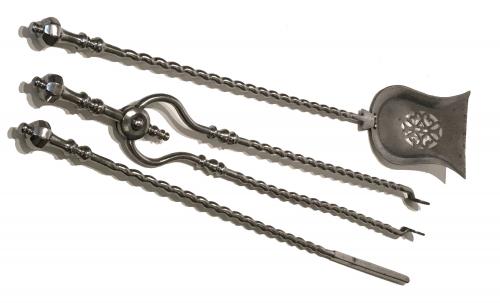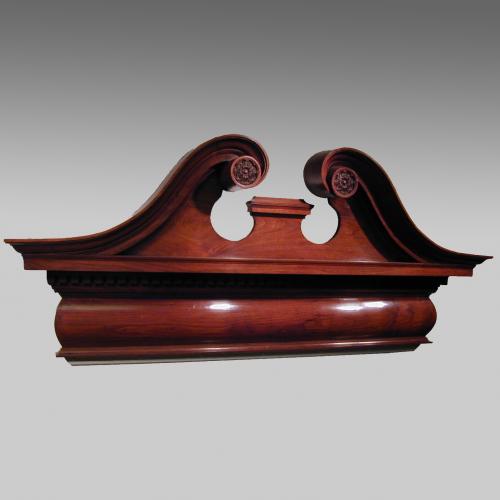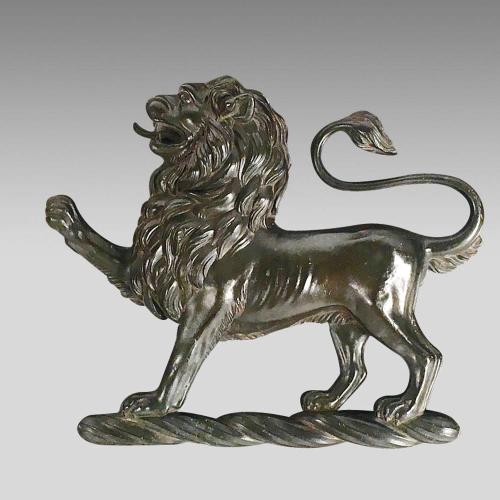

Price
£2250.00This object is eligible for a Certificate of BADA Provenance
The BADA Standard
- Since 1918, BADA has been the leading association for the antiques and fine art trade
- Members are elected for their knowledge, integrity and quality of stock
- Our clients are protected by BADA’s code of conduct
- Our dealers’ membership is reviewed and renewed annually
- Bada.org is a non-profit site: clients deal directly with members and they pay no hidden fees
Renaissance cast lead relief plaque.
In the Neo-Classical Style, ‘Minerva Presents the Personification of Painting to the Circle of Arts and Sciences - The Seven Liberal Arts. In the style of the workshop of Hans Jakob Bayr (1574 – 1628), Augsburg, Germany, a master silver and goldsmith.
The lead relief within a border of fine palmettes and beading. An extremely fine and contemporary casting with a good, natural, dark patina. Several roundels from the same workshop can be found in the Rijksmuseum in Amsterdam. The original plaque circa 1600.
German, circa 17th century.
Diameter: 10.5” (20.7cm).
Stock No.9175.
Minerva (Athena) is the Goddess of poetry, medicine, wisdom, commerce, weaving, crafts and magic and is also known as the inventor of music. As such, she is frequently presented in art alongside the allegorical figures of ‘the arts and sciences’ and, in this instance, is introducing ‘Painting’ and, possibly, ‘Sculpture’, to the Seven Liberal Arts, personified by the female figures in the picture. They are Grammar, Rhetoric, Logic, Arithmetic, Geometry, Music and Astronomy - their tools, books and instruments around them.
The relief represents the ideology that painting and sculpture were worthy to be included into the realm of higher learning. One of the ‘arts’ holds the Caduceus, held by Mercury (Hermes) in Greek mythology, a staff entwined by two serpents and surmounted by wings. In relation to Mercury, the messenger of the gods, it is associated with writing and eloquence and represents peace. Another figure carries a globe and one plays a shawm.
The landscape is set with baroque Italianate buildings and classical ruins and depicts other symbols relevant to classical mythology, such as the lizard – representative of divine wisdom and good fortune, especially when associated with Hermes – and the winged ‘putto’ – an allegorical figure associated with Eros/Cupid as well as Erato, the muse of lyric poetry.
The Liberal Arts was the expression used to denote an education that was worthy of a ‘free’ person (liberalis: latin – appropriate for free men, girls and boys alike), especially during the Roman Empire. In the 5th century, Martianus Capella defined the seven elements of the Liberal Arts. It was the neo-classicism of the Renaissance period that saw the reintroduction of classical influences in art, subsequently the use of mythological characters and classical buildings and artefacts. The cognoscenti of the renaissance reasoned that they could restore the arts and letters to their former glory by emulating them in their art and buildings.
Other significant paintings of Minerva Presenting Painting to the Liberal Arts are:
Hans Von Aachen (Private Collection) 1552 – 1615
Elsheimer (Fitzwilliam Museum)
Lebrun (Louvre)
Pietro da Cortona (Uffizi Gallery)
Lead has been used for both functional and artistic purposes by many cultures throughout the world. It was known in Mesopotamia by the 6th millennium BC and was extensively used in the Middle Assyrian period (c. 1350–1000 BC), particularly for plaques and medallions. In ancient Egypt it was used for coins, weights, ornaments, utensils, ceramic glazes and solder. Many cast-lead votive offerings, religious tokens and pilgrim badges have been discovered from ancient and medieval times.
The Romans introduced the use of lead in roofs, and it reappeared in the medieval period. In the 17th and 18th centuries lead was also used in northern Europe for roof crestings, rainwater heads and cisterns, which were often highly decorated. From the 12th century it provided a flexible, weatherproof armature for stained-glass windows.
The principal use of lead is in sculpture. There are a number of ornate 12th-century English fonts in relief-cast lead (e.g. at the church of St Mary, Frampton-on-Severn, Glos), and in the 16th century it was used for plaquettes, the small-scale reliefs that contributed so much to the diffusion of Renaissance motifs.
The Renaissance passion for collecting bronze medals and plaquettes led to a demand for less expensive replicas, and these were made with great precision in lead. The metal also played an important role in the goldsmiths' trade. The fashion for elaborate relief ornament of the Renaissance and Mannerist periods called for a degree of skill in modelling that was beyond the powers of the average goldsmith.
The practice therefore grew for the pattern makers of Augsburg and Nuremberg, Germany, to sell lead models of ornamental details and figures from which goldsmiths working elsewhere could, in turn, make moulds. An extensive collection of these models is preserved in the Historisches Museum, Basel, Switzerland.
The trade expanded to include large medallions and plaquettes, the chief masters of which were the German goldsmiths Hans Jakob Bayr, Peter Flötner, Jonas Silber, and the Master H.G. (Hans Jamnitzer) as well as the Dutch goldsmith family of van Vianen.
Stock number
9175The BADA Standard
- Since 1918, BADA has been the leading association for the antiques and fine art trade
- Members are elected for their knowledge, integrity and quality of stock
- Our clients are protected by BADA’s code of conduct
- Our dealers’ membership is reviewed and renewed annually
- Bada.org is a non-profit site: clients deal directly with members and they pay no hidden fees




